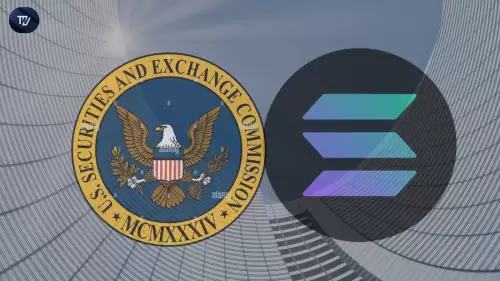 |
|
 |
|
 |
|
 |
|
 |
|
 |
|
 |
|
 |
|
 |
|
 |
|
 |
|
 |
|
 |
|
 |
|
 |
|
Cryptocurrency News Articles
Polygon: A Comprehensive Overview: Layer-2 Scaling Solution for Ethereum
Apr 01, 2024 at 03:00 am
Polygon, a layer 2 scaling solution for Ethereum, is poised for growth in 2023. The MATIC token, used for governance and transaction fees, is projected to rise in value throughout the year, reaching $1.30 by December. Technical analysis suggests MATIC is consolidating after a recent correction, with buyers defending the $0.9 support level. Polygon's focus on scalability, interoperability, and the upcoming Polygon 2.0 upgrade are key factors driving investor sentiment. Experts predict MATIC's value will increase in the coming years, making it a viable investment opportunity for those interested in the cryptocurrency market.

Polygon: A Comprehensive Overview
Polygon, formerly known as Matic Network, has emerged as a pivotal platform dedicated to addressing the scalability challenges of the Ethereum (ETH) blockchain. Established in 2017 by a team of ex-Ethereum contributors, including Jaynti Kanani, Sandeep Nailwal, Anurag Arjun, and Mihailo Bjelic, Polygon's primary objective is to develop a comprehensive multi-chain system.
Over the years, Ether (ETH) has ascended to become the second-largest cryptocurrency by market capitalization, predominantly due to its role as a frontrunner in decentralized finance (DeFi). DeFi applications leverage smart contracts, automated contracts that execute when predefined conditions are met, simplifying the creation of decentralized applications (dApps).
Despite ETH's popularity, its widespread adoption has paradoxically challenged the Ethereum blockchain with escalating transaction fees and increased network congestion. This situation prompted the creation of Matic.
Matic's Innovative Solution
Matic introduced Plasma technology, a method that facilitated transactions off the main Ethereum chain before finalizing them on the main chain. This approach enabled faster transaction speeds without compromising the ability to utilize dApps or the broader Ethereum ecosystem. This layer-2 solution aimed not to overhaul the foundational blockchain layer but to allow operations beyond it.
In 2021, Matic transitioned to Polygon, signifying a shift in operational dynamics. The revamped platform strived for a genuinely interoperable network of mini-blockchains or sidechains, thereby broadening the scope of blockchain interoperability.
This transformation can be likened to an advanced layer-2 scaling solution, reflecting the original vision of its founders for evolving Matic into Polygon. It's important to highlight that on September 15, 2022, Ethereum transitioned to a proof-of-stake (PoS) consensus mechanism, a move anticipated to enhance network performance. The long-term implications of this development on platforms like Polygon are yet to be fully understood.
Polygon's Native Cryptocurrency: MATIC
Like all blockchain networks, Polygon features its native cryptocurrency, known as the polygon coin, with the ticker symbol MATIC. This token is utilized within the Polygon network for transaction fees, staking, and governance purposes.
MATIC: Working Module & Latest Updates
Polygon employs a modified proof-of-stake (PoS) consensus mechanism, which allows for consensus to be reached with the addition of each block, unlike the traditional PoS approach that requires the processing of numerous blocks for consensus. In this system, participants of the network pledge to lock up their MATIC tokens, refraining from trading or selling them, in return for the opportunity to validate transactions on the Polygon network. Validators who successfully verify transactions are compensated with MATIC tokens.
The core structure of the Polygon network includes a primary blockchain that connects to Ethereum and various other blockchains, supported by numerous side chains branching off from it. These side chains are categorized into three types. Zk-Rollups bundle several cryptocurrency transfers into a single transaction, while Plasma Chains group transactions into blocks. Optimistic Rollups function similarly to Plasma Chains but have the added capability to interact with smart contracts, which are computer programs that execute automatically under predefined conditions.
Serving as a layer-2 scaling solution, Polygon seeks to overcome the challenges faced by the Ethereum network, specifically the high costs of transactions and their slow processing times. Polygon offers the capabilities to:
- Launch existing blockchains as well as create tailor-made blockchain networks.
- Facilitate interoperability between Ethereum and other blockchain systems.
- Assist existing blockchains in achieving compatibility with the Ethereum ecosystem.
Polygon vs. Ethereum
Polygon serves as a complementary layer-2 scaling solution that enhances the Ethereum blockchain. It is designed to augment Ethereum's capabilities as a platform for blockchain development. By offering extra functionalities in terms of security, sovereignty of individual blockchains, user and developer experiences, and modularity, Polygon extends Ethereum's utility.
Ethereum and Polygon both utilize a revised proof-of-stake (PoS) consensus mechanism, facilitating the rapid and cost-effective processing of transactions. Notably, Ethereum transitioned to a PoS consensus model in 2022, as detailed by Ledger Academy in "Understanding Ethereum's Proof of Stake Consensus Algorithm."
Latest Updates
- Zero-knowledge (ZK) proofs, a cryptographic method, are central to off-chain processing, allowing verification without exposing data. This is particularly useful in public blockchains. Polygon 2.0 integrates ZK technology to create a network of ZK-powered sidechains, aiming for massive scalability and unified liquidity.
- Between mid-June and mid-July 2023, Polygon underwent upgrades improving architecture, tokenomics, and governance. Polygon 2.0 seeks to strengthen its position as Ethereum's value layer, aiming to facilitate value creation and exchange globally.
- However, last week, Polygon disclosed that its zero-knowledge Ethereum Virtual Machine (zkEVM) was temporarily offline because of a problem with the blockchain sequencer. Through a message on Twitter, Polygon informed its audience of two million that this problem was exclusive to the zkEVM and did not affect any other blockchain developed with the Polygon Chain Development Kit (CDK).
MATIC Price Prediction: Price History
Polygon's pricing history reveals notable moments:
- MATIC debuted on the market in 2019, initially valued at under one cent. It crossed the $0.01 threshold later that year and primarily fluctuated around $0.02 for its initial years.
- The cryptocurrency surge in 2021, along with MATIC's rebranding to Polygon, sent it to new heights. It exceeded one dollar in early May and soared above $2 by mid-May. Despite a decrease over the subsequent summer, it recovered in the latter half of the year, reaching a record peak of $2.92 on December 27, 2021.
- The following year, 2022, was challenging for Polygon and the broader cryptocurrency market, with its value dropping below $1 in early May. After enduring several market downturns, falling below $0.50 in June, the launch of the zkEVM, an Ethereum Virtual Machine-compatible program, briefly pushed its value over $1 in August. It rose above $1 again in the fall, spurred by news of a collaboration with Meta, formerly known as Facebook, on non-fungible tokens (NFTs). However, the collapse of the FTX exchange marked a significant setback, ending the year at $0.7585, a 70% decrease from its value at the start of the year.
- 2023 turned out to be a year of ups and downs for Polygon. The cryptocurrency broke through the one-dollar mark in February, but faced a setback when the SEC's legal actions impacted MATIC's market value. On June 10, following the announcement that Crypto.com would be halting its institutional services in the United States, its price dropped to $0.5593.
- Subsequently, the price of MATIC saw a resurgence. On July 13, buoyed by a judicial decision favoring Ripple's XRP—declaring it not an unregistered security when traded on exchanges—the price ascended to $0.8775. However, this was followed by a downturn, with the price decreasing to $0.4946 by September 11. Nevertheless, a recovery ensued, and by November 14, the price had climbed to $0.9789.
- In recent months, the MATIC price witnessed a robust jump as it broke through the much-anticipated $1 mark following Bitcoin's record high. Recently, the MATIC price touched the peak of $1.3; however, it has since declined.
Polygon Price Prediction: Technical Analysis
Polygon is encountering resistance along the declining trend line, indicating that bears might be attempting a comeback. However, buyers continue to defend a decline below the $0.9 level. As of writing, MATIC price trades at $0.995, surging over 1.01% in the last 24 hours.
[MATIC/USDT Chart On TradingView](https://www.tradingview.com/x/z5UN5y0P/)
Should the price decline and breach the $0.9 support line, this would shift the short-term momentum towards the bears. Consequently, the MATIC/USDT pair might drop to $0.84, and potentially further to the 50-day SMA at $0.7.
To avert a downward trend, bulls need to drive the price beyond the declining trend line. Following this, the pair will strive to surpass the significant resistance at $1.1. Achieving this could initiate a new upward phase towards $1.3.
Polygon Price Prediction By Blockchain Reporter
| Year | Minimum ($) | Average ($) | Maximum ($) |
|---|---|---|---|
| 2024 | 1.35 | 1.40 | 1.51 |
| 2025 | 1.92 | 1.97 | 2.36 |
| 2026 | 2.80 | 2.90 | 3.33 |
| 2027 | 4.17 | 4.29 | 4.84 |
| 2028 | 5.78 | 6.00 | 7.15 |
| 2029 | 8.56 | 8.80 | 10.05 |
| 2030 | 12.1 |
Disclaimer:info@kdj.com
The information provided is not trading advice. kdj.com does not assume any responsibility for any investments made based on the information provided in this article. Cryptocurrencies are highly volatile and it is highly recommended that you invest with caution after thorough research!
If you believe that the content used on this website infringes your copyright, please contact us immediately (info@kdj.com) and we will delete it promptly.






























































